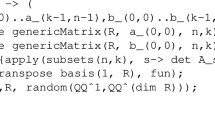Abstract
The Deodhar decomposition of the Grassmannian is a refinement of the Schubert, Richardson, and positroid stratifications of the Grassmannian. Go-diagrams are certain fillings of Ferrers diagrams with black stones, white stones, and pluses which index Deodhar components in the Grassmannian. We provide a series of corrective flips on diagrams which may be used to transform arbitrary fillings of Ferrers shapes with black stones, white stones, and pluses into a Go-diagram. This provides an extension of Lam and Williams’ Le-moves for transforming reduced diagrams into Le-diagrams to the context of non-reduced diagrams. Next, we address the question of describing when the closure of one Deodhar component is contained in the closure of another. We show that if one Go-diagram D is obtained from another \(D'\) by replacing certain stones with pluses, then applying corrective flips, that there is a containment of closures of the associated Deodhar components, \(\overline{{\mathcal {D}}'} \subset {\overline{{\mathcal {D}}}}\). Finally, we address the question of verifying whether an arbitrary filling of a Ferrers shape with black stones, white stones, and pluses is a Go-diagram. We show that no reasonable description of the class of Go-diagrams in terms of forbidden subdiagrams can exist by providing an injection from the set of valid Go-diagrams to the set of minimal forbidden subdiagrams for the class of Go-diagrams. In lieu of such a description, we offer an inductive characterization of the class of Go-diagrams.
Similar content being viewed by others
Notes
Positroids were originally defined to stratify positive Grassmannian. There have been several extensions of this stratification to the entire Grassmannian. When we say “positroid strata,” we mean the stratification of the Grassmannian by projections of Richardson varieties in the full flag manifold, studied in [6].
References
S. Agarwala and C. Marcott. Wilson loops in SYM \(N=4\)do not parametrize an orientable space, arXiv:1807.05397
N. Bergeron and S. Billey.RC-graphs and Schubert polynomials,Exper. Math.., 2(4): 257–269 (1993).
S. Billey and V. Lakshmibai. Singular Loci of Schubert Varieties, Springer Progress in Mathematics, 182 (2000).
V. Deodhar. On some geometric aspects of Bruhat orderings. I. A finer decomposition of Bruhat cells, Inventa. Math.. 79(3), 400–511 (1985)
O. Dudas. Note on the Deodhar decomposition of a double Schubert cell, arXiv:0807.2198.
A. Knutson, T. Lam, and D. Speyer. Positroid varities: juggling and geometry, Compositio Matha., 149(10), –1752 (2013).
Y. Kodama. KP Solitons and the Grassmannians Springer Briefs in Mathematical Physics, 22 (2017).
Y. Kodama and L. Williams. The Deodhar decomposition of the Grassmannian and the regularity of KP solitons, Adva. Matha., 244: 979–1032 (2013).
Y. Kodama and L. Williams. KP solitons and total positivity for the Grassmannian, Inventa. Matha., 198(3):637–699 (2014).
T. Lam and L. Williams. Total positivity for cominuscule Grassmannians, New York J. Matha., 14:53–99 (2008).
G. Lusztig. Total positivity for partial flag varieties, Representa. Theory, 2: 70–78 (1998).
R. J. Marsh and K. Rietsch. Parameterizations of flag varieties, Representa. Theory, 8: 212–242 (2004).
S. Oh. Combinatorics of positroids, FPSAC Conference Proceedings, 721–732 (2009).
A. Postnikov. Total positivity, Grassmannians, and networks, preprint, http://math.mit.edu/\(\sim \)apost/papers/tpgrass.pdf (2006).
K. Talaska and L. Williams. Network parametrizations for the Grassmannian, Algebra Number Theory, 7(9): 2275–2311 (2013).
Author information
Authors and Affiliations
Corresponding author
Additional information
Publisher's Note
Springer Nature remains neutral with regard to jurisdictional claims in published maps and institutional affiliations.
Rights and permissions
About this article
Cite this article
Marcott, C. Combinatorics of the Deodhar Decomposition of the Grassmannian. Ann. Comb. 24, 171–201 (2020). https://doi.org/10.1007/s00026-019-00489-w
Received:
Accepted:
Published:
Issue Date:
DOI: https://doi.org/10.1007/s00026-019-00489-w




